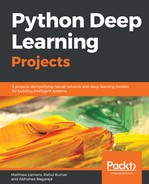In this chapter, we covered the basic RNN cells, LSTM cells and seq2seq model to build the language model which can be used for multiple NLP tasks. We implemented a chatbot from scratch to answer the questions by generating the sequence of words from the provided dataset.
The experience in this exercise demonstrates the value of LSTM as a often necessary component of the RNN. With the LSTM we were able to see improvements over past CNN models in that:
- The LSTM was able to preserve state information.
- The length of sentences for both inputs and outputs could be variable and different.
- The LSTM was able to adequately handle complex context.
Specifically, we:
- Gained an intuition about the RNN and its primary forms
- Implemented a language model using RNN
- Learned about the Long-Short Term Memory (LSTM) Model
- Implemented the LSTM language model and compare it to the RNN
- Implemented an Encoder-Decoder RNN based on the LSTM unit for a simple sequence to sequence question answer task
With the right training data, it would be possible to use this model to achieve the hypothetical client's goal (the Restaurant chain) of building a robust chatbot (in combination with other computational linguistic technologies we've explored) that could automate the over the phone food ordering process.
Well Done!
